Fixing Foam Rot

Woofer repair on Radio Shack 40-5037 Linaeum Speaker
Monday, January 28, 2013

No, the picture above isn’t the 5” woofer for the little Radio Shack / RCA speaker. It’s a 12” woofer from the 1980s, but it is an extreme case of a rotten surround. They rot regardless whether they are played loud or stored away.
Here’s the same speaker after the surround was replaced. Good as new. New foam for 4 speakers and all supplies needed came from Parts Express in a kit for about $30. Parts Express also has video instructions posted on YouTube if you want to see the process.
The use of foam surrounds for speakers started in the 1970s. Foam has advantages for performance, but it hardens and cracks after a few years.

My Radio Shack Linaeums are about 12 years old now, and a few days ago I was playing some jazz with a loud bass solo. It sounded distorted, so I turned down the volume, but clearly something wasn’t right. Pulling the grille off, the foam had blown out.
My first thought was to order another kit from PE, but the smallest they have is 6.5”. I looked on eBay, and there were lots of kits for 5.25” woofers, but 5” are hard to find. Search on <5”> as well as <5 inch> and <5 in>, and you may get lucky. I found some here. The price is reasonable, but you’re buying only the foam rings, not a kit. You’ll need glue, like Elmer’s white glue, a foam swab, a sharp utility knife, and a philips screwdriver.
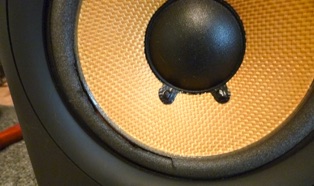


First order of business is a good dusting with a paint brush. Don’t touch the tweeter film. Pry out the 4 rubber grommets that hold the front grille. Remove the 4 screws under them and pry off the front panel. Unplug the woofer and remove the 4 screws holding it. Nice little 6 ohm woofer, with a woven Kevlar cone, vented polepiece, and shielded magnet.
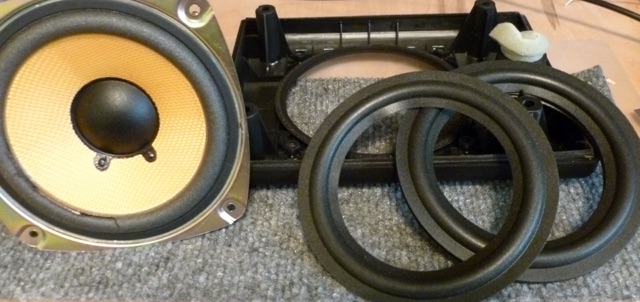
Different from most speakers, the surround is glued to the back of the cone instead of the front. That makes cleaning off the old foam and gluing the new foam more difficult, but it’s not a big deal. The new surrounds are just a hair larger inside and outside diameter than the originals, but close enough. Cut off the old foam, cut, peel, and scrape off the old glue from the frame. I tried to peel the old glue off the edge of the cone, but that turned out to be a bad idea. The Kevlar unraveled a few places. Better to just leave it in place. I have not found it necessary to remove the dust cap and shim the voice coil on any of the speakers I’ve re-foamed. Just use a bit of care.

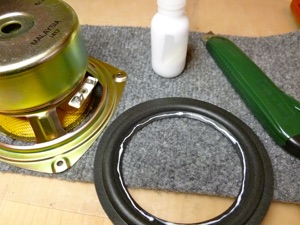
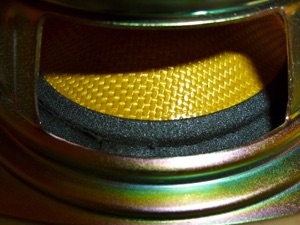

Apply glue to the inner lip of the surround and the back of the cone, spread it evenly with a foam swab, and wait about 5 minutes for it to get really tacky, almost clear. Pull the foam over the cone, center it carefully, and press the foam and cone together on opposite sides. Work your way around the cone pressing them together. Set the speaker aside for an hour or more for the glue to dry.
Next apply glue to the outer edge of the foam and the speaker frame. Be sure the cone is centered and moves in and out without scraping, and press the foam down into place. Let dry for 15 minutes or so and go back and press again to be sure it’s well adhered. That’s all there is to it.
Put the speaker back together. Before closing it up, I stuck some sticky-back foam to the inside bare walls of the box for damping and added a fairly dense stuffing of dacron pillow filling because I prefer “tight” non-resonant bass. I use these with subwoofers, so I’m not looking for the last ounce of boom from the small woofers.
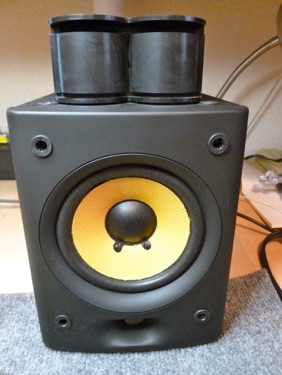
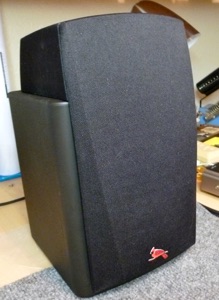
I like the open, airy high end the Linaeum tweeters provide. It’s a good compromise between constant power into the room and constant pressure direct to the listener as frequency rises. Some speakers deliver constant power on axis, but as the frequency goes up and the beam narrows, the power delivered into the room falls off, and the speakers sound dull outside the magic listening spot. The Linaeum tweeter does have a wide beam front and back, but it radiates in all directions, so even if you’re off to one side, you can hear the music, even if not balanced as well as in the sweet spot. The sweet spot is also big enough to share.
Too bad these aren’t still in production. Google the part number 40-5037 for more reviews and info.

